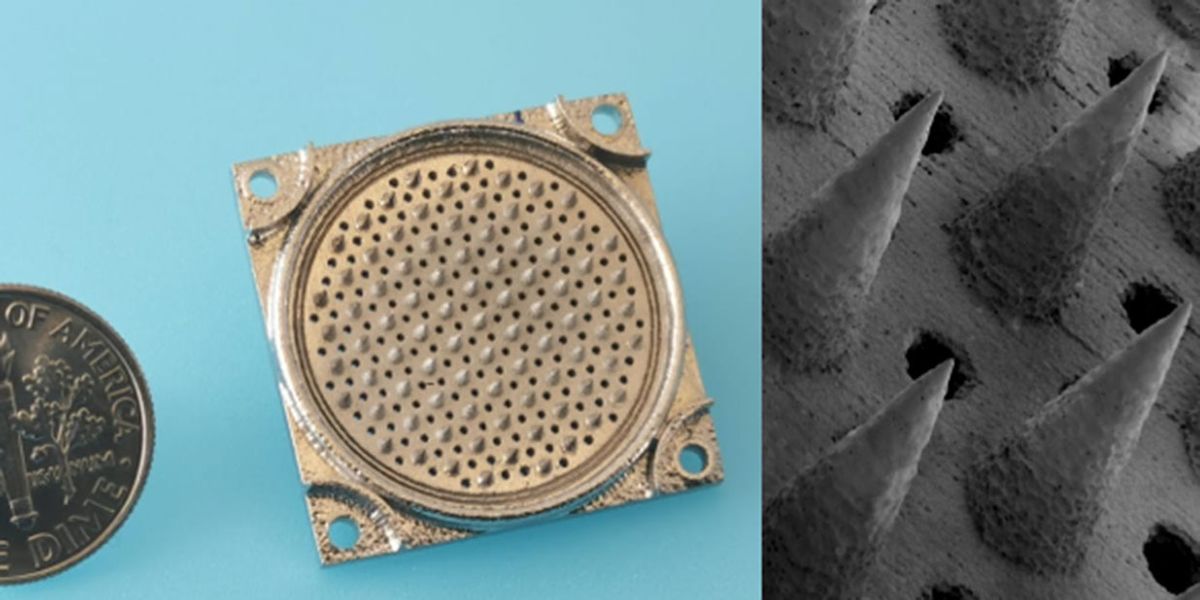A new 3-D printed electric thruster could one day help make advanced miniature satellites significantly easier and more affordable to build, a new study finds.
Conventional rockets use chemical reactions to generate propulsion. In contrast, electric thrusters produce thrust by using electric fields to accelerate electrically charged propellants away from a spacecraft.
The main weakness of electric propulsion is that it generates much less thrust than chemical rockets, making it too weak to launch a spacecraft from Earth’s surface. On the other hand, electric thrusters are extremely efficient at generating thrust, given the small amount of propellant they carry. This makes them very useful where every bit of weight matters, as in the case of a satellite that’s already in orbit.
Electric thrusters have propelled spacecraft for decades, but these have often relied on compressed gases stored in bulky pressurized tanks, as well as pipes, valves and pumps to shuttle those gases around. A new kind of electric rocket, known as an electrospray thruster, instead relies on salty fluid propellants known as ionic liquids.
The new 3D-printed electrospray thruster is roughly the size of a dime. Inside the device is an array of miniature cones that are each covered with a forest of zinc oxide nanowires. These nanowires act like candlewicks, drawing liquid from a reservoir onto the cones. When the cones generate electric fields, they spray ions out microscopic nozzles.
The amount of force the new thruster generates is a few dozen micronewtons, roughly equal to half the weight of a sesame seed. Still, in the absence of air friction in outer space, even such a minuscule amount of force could help a miniature spacecraft maneuver in orbit. CubeSats are each just the size of a Rubik's Cube and weigh about 1 kilogram. Envisioned CubeSat applications include one day providing satellite-based Internet or Earth-observing networks, says study senior author Luis Fernando Velásquez-García, principal research scientist at MIT’s Microsystems Technology Laboratories.
The new device is the first electrospray thruster produced entirely using additive manufacturing techniques: Its body was made using 3-D printing, whereas the zinc oxide nanowires were grown in reactors. As such, the researchers say it could prove far cheaper and faster to make than other electrospray thrusters made using subtractive manufacturing techniques such as laser machining.
“Making the devices via 3D printing is 1 percent of the cost and time it takes making them in the cleanroom,” says Velásquez-García. “There’s this idea that space is for the best and wealthiest, and our work could help change that. Space is for everyone.”
The researchers note their new invention is also the first electrospray thruster to emit a stream of pure ions, instead of ions mixed in with electrically neutrally charged molecules as other electrospray thrusters do. This means it can use its electrical fields on more of its spray than other electrospray thrusters, giving it more thrust per unit of spray and operating more efficiently overall. Such efficiency is key for objects in orbit, since refueling satellites is rarely an option.
Velásquez-García says these new engines could help prolong the lifespan of satellites around Earth by keeping their orbits from decaying, or prove useful for probes on deep-space missions.
“A key advantage of 3-D printing is that it allows you to aggressively iterate designs,” Velásquez-García adds. “In 3-D printing, it’s okay to make mistakes. You learn from your mistakes, and you have the time and resources to make better devices.”
More research is needed before these 3D-printed thrusters can reach the market, Velásquez-García says, including understanding whether the devices degrade after long-term operation, and building thrusters with larger, denser emitter arrays.
Velásquez-García and study lead author Dulce Viridiana Melo Máximo detailed their findings in the December issue of the journal Additive Manufacturing.
Charles Q. Choi is a science reporter who contributes regularly to IEEE Spectrum. He has written for Scientific American, The New York Times, Wired, and Science, among others.



